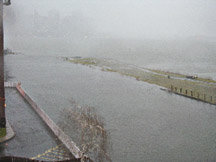Downtown Jersey City residents hope that any future storm will not resemble what took place during the rainy weekend of March 12-14.
The rainfall, according to the National Weather Service, measured a total of more than five inches and came with wind gusts upwards of 50 mph. It also flooded basements and “garden apartments” in different parts of the city, backing up sewage in some cases.
The storms also closed off some streets that got flooded.
The complaints weren’t new. Back in 2007, several Downtown residents demanded answers from city officials about flooding. The city noted that Jersey City has a “combined sewer system” that is over 100 years old, meaning that both wastewater and storm water flow through the same pipes.
“I haven’t really processed what happened.” – Lynn Franks
________
Three years after the 2007 complaints, residents like Lynn Franks, who saw the majority of her belongings in her ground-level Bright Street apartment ruined from flooding, are furious again.
“The area where I live in is always flooding, which I found out after the fact,” said a frustrated Franks, who moved into her apartment over a year ago. “The city must know this is a low-level geographically, but it seems like nothing has been done to deal with this problem.”
Her ground-floor apartment had a foot of water in some areas, she said.
The havoc the rain wrought
The management company that maintains the apartment building she lives in has already replaced the drywall damaged from the rains. She praised their effort as “above and beyond.”
Yet she wonders why her landlord would rent out her apartment, as Franks began to find out from other residents about the flooding problems that plague her area.
“The people who live above my apartment came around and said [they] knew,” Franks said. “It’s a bad situation and it shows me that some landlords, at least this one, are in it for the money.”
Her landlord is Jeffrey Zak, who along with Peter Mocco not only owns the apartment building, but the two are also the developers of the Liberty Harbor development community in downtown Jersey City. Both Zak and Mocco did not return calls to their offices about problems with flooding at their Downtown properties.
Franks said she would like to move, but has found it difficult to find an affordable apartment in Jersey City that allows her to live with her dog and cat.
She said she does not have any family living in close proximity, and was fortunate that her brother, who lives in upstate New York, was in the NY/NJ Metropolitan area to check on a commercial building he owns, and was able to help her evacuate from the apartment.
Franks said she found a motel outside the city that allowed her and her pets to stay for a night.
Looking back, Franks still hasn’t quite come to grips with what she went through.
“I haven’t really processed what happened,” Franks said. “I am totally exhausted.”
Two to five feet above sea level
The area where Franks resides is one of several areas in downtown Jersey City most susceptible to flooding due to two things: they lie about two to five feet above sea level, and are served by combined sewers.
Other flooding downtown areas include the intersection of Wayne and Merseles Streets, Third and Colgate Streets, and York Street, particularly during that last major rainstorm.
According to city spokesperson Jennifer Morrill, the majority of the 174 calls for service received by the Police and Fire departments during that storm were actually in the Country Village area, in the city’s Greenville section.
The Municipal Utilities Authority, through city spokesperson Morrill, said they will embark in 2011 on the design and construction of improvements to sewers on Sixth Street and 10th Street. Also, the MUA has retained the services of a company to clean the sewer system interceptor (a large sewer line that controls the flow of sewage in a combined sewer system) from 18th street to the East Side Pump Station located by Liberty Science Center.
Since 2007, the MUA has had in place the Capacity and Condition Assessment program to inspect and identify areas for cleaning catch basins, spot repairs, sewer relining and replacement to keep the sewer system in working condition. But for some, the new improvements won’t come quickly enough.
Ricardo Kaulessar can be reached at rkaulessar@hudsonreporter.com.
